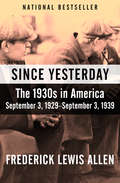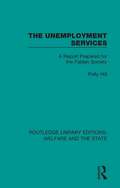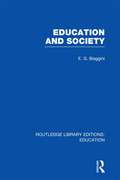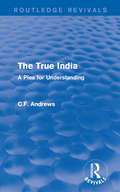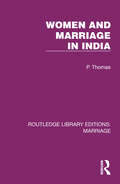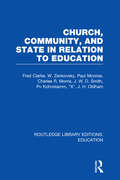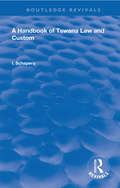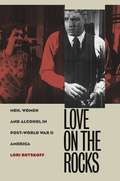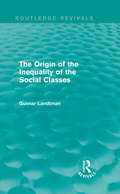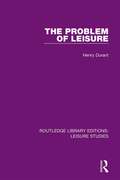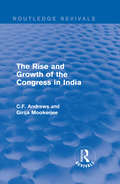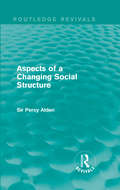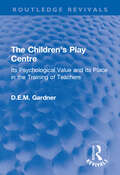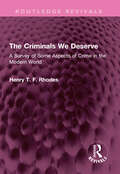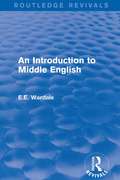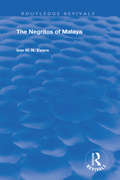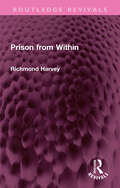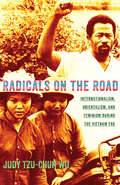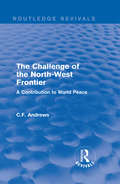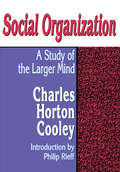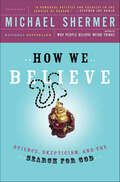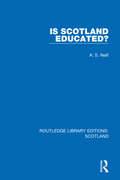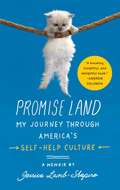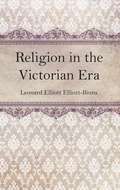- Table View
- List View
Since Yesterday: The 1930s in America, September 3, 1929–September 3, 1939
by Frederick Lewis AllenHeralded by the New York Times as "a shrewd, concise, wonderfully written account of America in the '30s . . . a reminder of why history matters," the bestselling sequel to Only Yesterday illuminates the events that brought America back from the brink Published in 1940, Since Yesterday takes up where Lewis's classic leaves off. Opening on September 3, 1929, in the days before the stock market crash, this information-packed volume takes us through one of America's darkest times all the way to the light at the end of the tunnel. Following Black Tuesday, America plunged into the Great Depression. Panic and fear gripped the nation. Banks were closing everywhere. In some cities, 84 percent of the population was unemployed and starving. When Franklin D. Roosevelt took office in 1933, public confidence in the nation slowly began to grow, and by 1936, the industrial average, which had plummeted in 1929 from 125 to fifty-eight, had risen again to almost one hundred. But America still had a long road ahead. Popular historian Frederick Lewis Allen brings to life these ten critical years. With wit and empathy, he draws a devastating economic picture of small businesses swallowed up by large corporations--a ruthless bottom line not so different from what we see today. Allen also chronicles the decade's lighter side: the fashions, morals, sports, and candid cameras that were revolutionizing Americans' lives. From the Lindbergh kidnapping to the New Deal, from the devastating dust storms that raged through our farmlands to the rise of Benny Goodman, the public adoration of Shirley Temple, and our mass escape to the movies, this book is a hopeful and powerful reminder of why history matters.
The Unemployment Services: A Report Prepared for the Fabian Society (Routledge Library Editions: Welfare and the State #7)
by Polly HillOriginally published in 1940, The Unemployment Services provides a thorough examination of the system of unemployment relief. The book looks at fundamental proposals for the extension of necessary provisions for improving the conditions of the unemployed, and their dependents. The book provides a detailed knowledge of regulations and scales, and uses an unorthodox dissection of the principles embodied in this code of laws, which plays so large a part in the lives of industrial workers and their dependents.
Education and Society (Routledge Library Editions: Education #166)
by E. G. BiagginiThis volume discusses how the lay-person responds to written appeals to his intelligence and feelings with particular emphasis on education and culture. The author indicates a possible approach to the task of investigation rather than all that can be done with the method employed. The second part deals with educational questions relevant to the evidence and examines the social implications of this evidence.
Routledge Revivals (1939): A Plea for Understanding
by C.F. AndrewsFirst published in 1939, this book sets out to refute some of the ‘unjust charges laid at India’s door’ and correct the ‘false impressions’ that prevailed at the time. The author argues that the distorted view of the social conditions in India in the contemporary press and literature were detrimental to the relationships between East and West. Attempting to give a picture of the true state of affairs, they show that Hinduism was reforming from within and that it was unjust to still equate it with earlier periods. The Depressed classes, women’s rights, child marriage, Caste and Kalighat are all examined in detail. The book will be interest to students of colonial India and social history.
Women and Marriage in India (Routledge Library Editions: Marriage)
by P. ThomasWomen in the thraldom of man has led sometimes, in one form or another, to the most horrible abuses. In this book, originally published in 1939, the author traces and analyses the institutions of marriage and family in India. The women of India, after their ancient matriarchal supremacy, declined into medieval degradation and slavery, brought about by subtle and prolonged subjugation by men through the instrumentality of legal restraints, supposed religious grounds, the Purdah, child-marriage and widow-burning. These iniquities were practised under the sanctified excuse of matrimony. The author points out, in this objective sociological study, practical methods of emancipation of Indian women, and urges the necessity for a radical change of values which would give the greater impetus to these vitally necessary reforms. The book is of especial interest as a sociological study of a curious and cruel form of organized inhumanity. Today it can be read and enjoyed in its historical context. This book is a re-issue originally published in 1939. The language used and views portrayed are a reflection of its era and no offence is meant by the Publishers to any reader by this re-publication.
Church, Community and State in Relation to Education: Towards a Theory of School Organization (Routledge Library Editions: Education)
by Fred ClarkeThis volume was originally prepared for the World Conference on Church, Community and State held in Oxford in 1937. Its aim was to understand the nature of the vital conflict between the Christian faith and the secular tendencies of the early twentieth century, particularly in relation to education. The book also analyses the responsibilities of the Church in this struggle.
A Handbook of Tswana Law and Custom (Routledge Revivals)
by I. SchaperaOriginally published in 1938, the primary object of this book was to place on record, for the information and guidance of government officials and of the Tswana themselves, the traditional and modern laws and related customs of the Tswana tribes of the Bechuanaland Protectorate. The author was invited in 1934 by the Administration of the Protectorate to undertake the compilation of such a record and the book does not pretend to give a complete account of Tswana life, but deals only with those aspects which may be regarded as falling within the province of tribal law.
Jews and Intermarriage in Nazi Austria
by Evan Burr BukeyEvan Burr Bukey explores the experience of intermarried couples - marriages with Jewish and non-Jewish partners - and their children in Vienna after Germany's seizure of Austria in 1938. These families coped with changing regulations that disrupted family life, pitted relatives against each other, and raised profound questions about religious, ethnic, and national identity. Bukey finds that although intermarried couples lived in a state of fear and anxiety, many managed to mitigate, delay, or even escape Nazi sanctions. Drawing on extensive archival research, his study reveals how hundreds of them pursued ingenious strategies to preserve their assets, to improve their "racial" status, and above all to safeguard the position of their children. It also analyzes cases of intermarried partners who chose divorce as well as persons involved in illicit liaisons with non-Jews. Jews and Intermarriage in Nazi Austria concludes that although most of Vienna's intermarried Jews survived the Holocaust, several hundred Jewish partners were deported to their deaths and children of such couples were frequently subjected to Gestapo harassment.
Love on the Rocks
by Lori RotskoffIn this fascinating history of alcohol in postwar American culture, Lori Rotskoff draws on short stories, advertisements, medical writings, and Hollywood films to investigate how gender norms and ideologies of marriage intersected with scientific and popular ideas about drinking and alcoholism. After the repeal of Prohibition in 1933, recreational drinking became increasingly accepted among white, suburban, middle-class men and women. But excessive or habitual drinking plagued many families. How did people view the "problem drinkers" in their midst? How did husbands and wives learn to cope within an "alcoholic marriage"? And how was drinking linked to broader social concerns during the Great Depression, World War II, and the Cold War era?By the 1950s, Rotskoff explains, mental health experts, movie producers, and members of self-help groups like Alcoholics Anonymous and Al-Anon helped bring about a shift in the public perception of alcoholism from "sin" to "sickness." Yet alcoholism was also viewed as a family problem that expressed gender-role failure for both women and men. On the silver screen (in movies such as The Lost Weekend and The Best Years of Our Lives) and on the printed page (in stories by such writers as John Cheever), in hospitals and at Twelve Step meetings, chronic drunkenness became one of the most pressing public health issues of the day.Shedding new light on the history of gender, marriage, and family life from the 1920s through the 1960s, this innovative book also opens new perspectives on the history of leisure and class affiliation, attitudes toward consumerism and addiction, and the development of a therapeutic culture.
The Origin of the Inequality of the Social Classes (Routledge Revivals)
by Gunnar LandtmanOriginally published in 1938, The Origin of the Inequality of the Social Classes presents ethnological research into how rank and inequality has been created or formed in various societies. This study especially focuses on recent changes in aboriginal cultures with particular attention paid to the Kiwai Papuans of British New Guinea whom Landtman researched extensively from 1910-1912. This title will be of interest to students of Sociology and Anthropology.
The Problem of Leisure (Routledge Library Editions: Leisure Studies)
by Henry DurantFirst published in 1938. This study examines various aspects of leisure in the early twentieth century. The author observes the differences in leisure between the various echelons of society, as well as the differences of leisure amongst children and adults. Durant also explores in depth several modes of leisure, including the cinema, sport, and gambling. This title will be of interest to students of history, sociology, and leisure studies.
Routledge Revivals (1938): The Rise And Growth Of The Congress In India (1938)
by C.F. Andrews Girija MookerjeeFirst published in 1938, this book aims to provide a history of the rise and growth of the Indian National Congress for the general reader, covering the period from its foundation in 1885 until the beginning of the non-co-operation movement in 1920. It was intended to extend the official history of the Congress by Pattabhi Sitarammayya by making it more accessible to western readers while also giving more space to the religious and social forces in Indian history during the nineteenth century which led to the birth of the congress. It also looks at forerunner organisations like The British Indian Association before examining the history and evolution of the congress in several phases.
Aspects of a Changing Social Structure (Routledge Revivals)
by Sir Percy AldenOriginally published in 1937, Aspects of a Changing Social Structure presents lectures delivered in 1936 on behalf of the Sir Halley Stewart Trust. These lectures focus on discussing the interest that government was beginning to take in Britain’s social welfare and industrial patterns. Topics covered include nutrition, child welfare, housing and health in relation to individuals and the state as well as new developments in industrial organisation and the future of the agricultural and coal industry. This title will be of interest to students of Sociology and History.
The Children's Play Centre: Its Psychological Value and its Place in the Training of Teachers (Routledge Revivals)
by D.E.M. GardnerFirst published in 1937, The Children’s Play Centre is an account of Gardner’s Play Centre and her work in assessing its value in the education of children and the training of teachers. The book puts forward the value of play in the development of children and provides a detailed report of Gardner’s experiment. It also explores the significance of the Play Centre to the technique of training students. It will have lasting relevance for those interested in the history of education and the psychology of education.
The Criminals We Deserve: A Survey of Some Aspects of Crime in the Modern World (Routledge Revivals)
by Henry T. RhodesFirst published in 1937, The Criminals We Deserve asks what kind of criminals does our society deserve? Some people thought that our crime problem was less serious than formerly. Mr. Rhodes, on the other hand, shows how profound changes which took place in our social institutions during the thirty years before 1937, had altered the nature of modern crime, making it more dangerous to society. He explains how our social organization determined the nature of our crime problem, and illustrates his thesis with many strange and arresting examples of criminal behaviour in which tragedy and comedy are often mingled. This book will be of interest to students of criminology, history and sociology.
An Introduction to Middle English
by E.E. WardaleFirst published in 1937, this book supplies a history of the living growth of the English language from Old English to the medieval period. It offers an in-depth study of the growth of vocabulary through literature and social interaction, bringing out the fact that it is chiefly words that foreign influence has affected — leaving sentence structure almost unaltered. Isolative and combinative changes in phonology, the accidence of nouns and plurals, pronouns and adverbs, and verbs are also examined in detail, along with a general overview of the features Middle English and a brief outline of each dialect’s most striking characteristics.
The Negritos of Malaya (Routledge Revivals)
by Ivor H. EvansPublished in 1937. This book, written by the well-known authority on the ethnology and archaeology of the Malay Peninsula, presents a compact and detailed account of the Negritos, one of the three paga races of the Peninsula. It brings up to date much of the previous work on this subject, and deals with all aspects of their character and environment. By way of introduction, there is a general description of the geography and development of the Peninsula, together with a discussion of statistics concerning the tribe's distribution, their health, habitat, and territories. The author then examines the various aspects of their everyday life, including social and domestic customs, hunting, agriculture, dress, ornamentation, musical instruments, and art, as well as their religious beliefs and superstitions. The chapters on their weapons are particularly detailed and informative, and the book is supported throughout by useful illustrations. Although many further studies of this area and its people have been made since the first publication of this book in 1937, its methodical and careful documentation has yet to be superseded, and it remains indispensable to all students of anthropology and sociology.
Prison from Within (Routledge Revivals)
by Richmond HarveyFirst published in 1937, Prison from Within is a first-person account of a prisoner sentenced to imprisonment for eighteen months for fraud. It is a linear narrative honestly recording the various facets of prison culture, along with candid character analysis. The book touches upon philosophical notions of sin and remorse; the social groups of prisoners and the camaraderie shared among them; the poor living condition of prisons and the exploitation of prison labour; and the general politics of the time. The book successfully humanizes criminals and is an excellent reminder of the fact that the prison industry has only worsened with time. Prisons were designed for the purpose of ‘cleansing’ bourgeoise society; therefore, it is important to revisit the institution and question its utility in modern times. This book will be of interest to students and teachers of history, sociology, criminology, criminal justice, literature, and penology.
Radicals On The Road: Internationalism, Orientalism, and Feminism during the Vietnam Era (The United States in the World)
by Judy Tzu-Chun WuTraveling to Hanoi during the U. S. war in Vietnam was a long and dangerous undertaking. Even though a neutral commission operated the flights, the possibility of being shot down by bombers in the air and antiaircraft guns on the ground was very real. American travelers recalled landing in blackout conditions, without lights even for the runway, and upon their arrival seeking refuge immediately in bomb shelters. Despite these dangers, they felt compelled to journey to a land at war with their own country, believing that these efforts could change the political imaginaries of other members of the American citizenry and even alter U. S. policies in Southeast Asia. In Radicals on the Road, Judy Tzu-Chun Wu tells the story of international journeys made by significant yet underrecognized historical figures such as African American leaders Robert Browne, Eldridge Cleaver, and Elaine Brown; Asian American radicals Alex Hing and Pat Sumi; Chicana activist Betita Martinez; as well as women's peace and liberation advocates Cora Weiss and Charlotte Bunch. These men and women of varying ages, races, sexual identities, class backgrounds, and religious faiths held diverse political views. Nevertheless, they all believed that the U. S. war in Vietnam was immoral and unjustified. In times of military conflict, heightened nationalism is the norm. Powerful institutions, like the government and the media, work together to promote a culture of hyperpatriotism. Some Americans, though, questioned their expected obligations and instead imagined themselves as "internationalists," as members of communities that transcended national boundaries. Their Asian political collaborators, who included Buddhist monk Thich Nhat Hanh, Foreign Minister of the Provisional Revolutionary Government Nguyen Thi Binh and the Vietnam Women's Union, cultivated relationships with U. S. travelers. These partners from the East and the West worked together to foster what Wu describes as a politically radical orientalist sensibility. By focusing on the travels of individuals who saw themselves as part of an international community of antiwar activists, Wu analyzes how actual interactions among people from several nations inspired transnational identities and multiracial coalitions and challenged the political commitments and personal relationships of individual activists.
Routledge Revivals (1937): A Contribution to World Peace
by C.F. AndrewsFirst published in 1937, this book grew out of the author’s belief that there needed to be a ‘drastic revision’ of British policy on the North-West Frontier of India (now Khyber Pakhtunkhwa in Pakistan) in order to achieve a lasting peace. The author examined the causes of continued hostility and non-military methods that might prevent further outbreaks of war — reducing or removing British troops and leaving the settlement of disputes to Indians. He traces the changing attitudes of Indians towards British rule and the increasing popularity of calls for independence while also detailing the wider Indian context. This book will be of interest to students of Indian and colonial history.
Social Organization: A Study of the Larger Mind
by Charles Horton CooleyThis classic text has set a standard for American sociol-ogy. Cooley provides analysis without empiricism, applying psychological insight to his study of the individual and collective self. First published in 1909, this work attempts to motivate man and society to be more responsible to each other.""The style of his book is clear and attractive, the text abounding in happy quotation.""--Annals of the American Academy of Political and Social Science
How We Believe: Science, Skepticism, and the Search for God
by Michael ShermerA new edition covering the latest scientific research on how the brain makes us believers or skepticsRecent polls report that 96 percent of Americans believe in God, and 73 percent believe that angels regularly visit Earth. Why is this? Why, despite the rise of science, technology, and secular education, are people turning to religion in greater numbers than ever before? Why do people believe in God at all? These provocative questions lie at the heart of How We Believe , an illuminating study of God, faith, and religion. Bestselling author Michael Shermer offers fresh and often startling insights into age-old questions, including how and why humans put their faith in a higher power, even in the face of scientific skepticism. Shermer has updated the book to explore the latest research and theories of psychiatrists, neuroscientists, epidemiologists, and philosophers, as well as the role of faith in our increasingly diverse modern world.Whether believers or nonbelievers, we are all driven by the need to understand the universe and our place in it. How We Believe is a brilliant scientific tour of this ancient and mysterious desire.
Is Scotland Educated? (Routledge Library Editions: Scotland #21)
by A. S. NeillOriginally published in 1936, and with more than a slightly tongue-in-cheek tone at times, the author of this book declares that Scotland is not educated but merely learned. This book does not deal with education in its narrowest sense: it ranges from the Kirk to Haggis, Tartans and Burns, Whisky and repressed sex in its discussion, proclaiming Calvinism as the root of most of Scotland’s evils. Honest and at times provocative, this volume does give direct access to the emotional roots of Neill’s feelings about Scottish education.
Promise Land
by Jessica Lamb-Shapiro"In writing this book I walked on hot coals, met a man making a weight-loss robot, joined a Healing Circle, and faced my debilitating fear of flying. Of all of these things, talking to my father about my mother's death was by far the hardest." The daughter of a widowed child psychologist and parenting author, Jessica Lamb-Shapiro grew up immersed in the culture of self-help, of books and pamphlets and board games and gadgets and endless jargon-filled conversations about feelings. It wasn't until she hit her thirties that Jessica began to wonder: if all this self-improvement arcana was as helpful as it promised to be, why wasn't she better adjusted? She had a flying phobia, hadn't settled down, and didn't like to talk about her feelings. Thus began Jessica's fascination with the eccentric and labyrinthine world of self-help. She read hundreds of books and articles, attended dating seminars, walked on hot coals, and attempted to conquer her fear of flying. But even as she made light of the sometimes dubious effectiveness of these as-seen-on-TV treatments, she slowly began to realize she was circling a much larger problem: her mother's death when she was a toddler, and the almost complete silence that she and her father had always observed on the subject. In the tradition of Augusten Burroughs, Jessica Lamb-Shapiro illuminates the peculiar neuroses and inalterable truths that bind families together, whether they choose to confront them or not. Promise Land is a tender, witty, and wise account of a young woman's journey through her own psyche toward the most difficult stage of grown-up emotional life: acceptance.
Religion in the Victorian Era
by Elliott-Binns Leonard ElliottA comprehensive history of religion in Victorian England, covering such topics as religion and science, religion and society, the press, literature and art, worship, new critical methods, federation and reunion, showing both the relationship between the churches and the society in which they existed and also the major movements within the churches.
